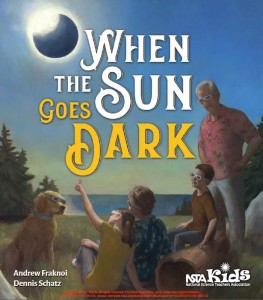 Just in time for the “All-American” eclipse of the Sun this August, When the Sun Goes Dark gives the full scoop for kids ages 8 through 12 about why eclipses are so interesting and so beautiful. Written by astronomers Andrew Fraknoi and Dennis Schatz, and published by the National Science Teachers Association Press, the book features hands-on activities for learning about the Moon, the Sun, and their eclipses that families can enjoy together.
Just in time for the “All-American” eclipse of the Sun this August, When the Sun Goes Dark gives the full scoop for kids ages 8 through 12 about why eclipses are so interesting and so beautiful. Written by astronomers Andrew Fraknoi and Dennis Schatz, and published by the National Science Teachers Association Press, the book features hands-on activities for learning about the Moon, the Sun, and their eclipses that families can enjoy together.
In 36 full-color pages, When the Sun Goes Dark tells how Diana and Sammy, two curious children, and their grandparents re-create eclipses in their living room using a lamp, tennis and ping-pong ball, and Hula Hoops. Later, in the backyard and around the house, the family explores safe ways to view both partial and total eclipses of the Sun. The book is a great introduction to eclipses for families and the perfect resource for teachers and librarians to be ready for the August 21, 2017 solar eclipse, which will be visible to 500 million people in North and Central America.
To order a copy, go to: http://www.nsta.org/store/product_detail.aspx?id=10.2505/9781681400112 or check on Amazon.
When the Sun Goes Dark is written by two experienced astronomers and educators (and the authors of the award-winning book for teachers, Solar Science, also published by the National Science Teachers Association.) The book is part of a series of children’s books designed by educators, called NSTA Kids, and is distributed to bookstores via Independent Publishers’ Group. Fraknoi is Chair of the Astronomy Department at Foothill College near San Francisco and a member of the national task force of astronomers for the eclipse. Schatz is the former Vice President of the Pacific Science Center in Seattle and author of over 20 other children’s books.
The book breaks the mold for children’s books on science, most of which just explain astronomical ideas like an encyclopedia with pictures. Instead, When the Sun Goes Dark encourages family interactions and a hands-on discovery approach to the ideas behind eclipses. You can see more about the book and eclipses, at: http://nsta.org/sundark
The August 21, 2017 eclipse of the Sun will be total on a narrow path, only 60 to 70 miles wide, stretching from a beach in Oregon to the barrier islands of the coast of South Carolina. During a total eclipse, the Moon fully covers the Sun, the sky turns so dark that stars come out, and the faint halo of an atmosphere around the Sun becomes visible. The rest of the U.S. (and Canada and Mexico) will see a partial eclipse, where the Moon covers only a part of the Sun and the sky stays brighter. Anytime the Sun is not fully covered by the Moon, people must protect their eyes with special eclipse glasses or by projecting a safe image of the Sun (as explained in When the Sun Goes Dark.)




Leave A Comment